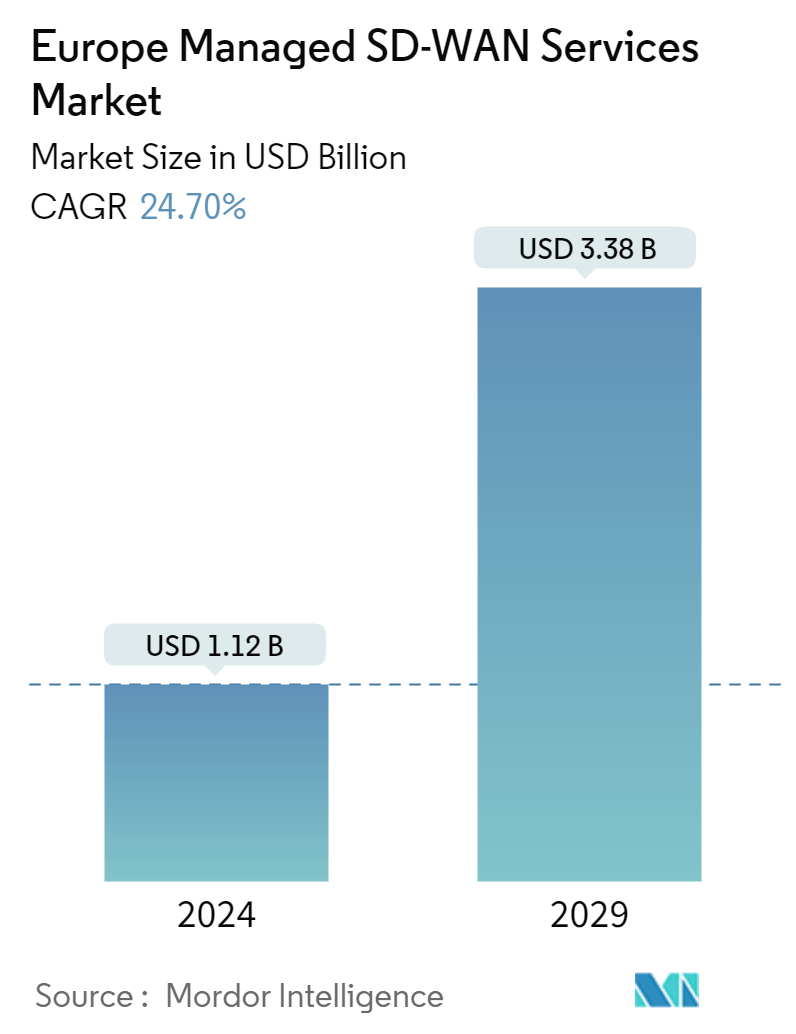Market Size of Europe Managed SD-WAN Services Industry

| Study Period | 2019 - 2029 |
| Base Year For Estimation | 2023 |
| Market Size (2024) | USD 1.12 Billion |
| Market Size (2029) | USD 3.38 Billion |
| CAGR (2024 - 2029) | 24.70 % |
| Market Concentration | Low |
Major Players
*Disclaimer: Major Players sorted in no particular order |
Europe Managed SD-WAN Services Market Analysis
The Europe Managed SD-WAN Services Market size is estimated at USD 1.12 billion in 2024, and is expected to reach USD 3.38 billion by 2029, growing at a CAGR of 24.70% during the forecast period (2024-2029).
The European managed SD-WAN services market is currently experiencing robust growth. SD-WAN presents telecommunication firms with a chance to shift from merely offering connectivity to becoming technology-focused service providers. Securing a prominent role in the SD-WAN platform arena positions providers as leaders in underlay, security, LAN, UCaaS, and voice services and facilitates a smooth transition into telecom expense management.
- With the significant migration of business applications to the cloud, organizations are increasingly seeking flexible solutions to direct branch office traffic to the cloud directly, bypassing the traditional route through the data center. Hosting an advanced SD-WAN on cloud platforms such as AWS or Microsoft Azure facilitates this, creating a direct tunnel for traffic from users to cloud services. This not only enhances application performance but also bolsters reliability and security.
- Advanced SD-WAN solutions incorporate WAN optimization features. These features combat latency, often caused by long distances, through compression algorithms and accelerated TCP protocols. Additionally, these solutions optimize SaaS application traffic. They achieve this by dynamically choosing the most efficient route, factoring in network conditions like packet loss, jitter, and latency. Furthermore, they prioritize the shortest path to the nearest point of presence (POP).
- Advanced SD-WAN solutions offer more than WAN optimization and routing features, such as BGP and OSPF. They also incorporate next-generation firewall capabilities. This consolidation of features allows organizations to streamline their branch network infrastructure. By replacing separate routers, firewalls, and WAN optimization devices with a single SD-WAN device, organizations save on power consumption and benefit from simplified management. Additionally, SD-WAN solutions can be deployed as virtual appliances, reducing equipment footprint and energy consumption. This unified approach cuts costs and minimizes errors that can arise from manually configuring disparate components.
- Remote workers utilize a range of tools, including cloud applications, virtual desktop apps, on-premises software, VoIP, and Software as a Service (SaaS). However, ensuring security and maintaining network performance pose significant challenges for these remote employees. While traditional network setups often struggle to keep pace with the diverse demands of remote work, SD-WAN stands out by providing secure connectivity, whether from public or private clouds and that too, from virtually anywhere with just an internet connection. Consequently, for companies embracing remote workforces, a well-managed SD-WAN network emerges as a critical asset.
- SD-WAN lacks inherent security features, leaving security management to individual providers. Notably, some vendors may fall short of providing robust security measures. A key hurdle with SD-WAN lies in the necessity to tailor and implement security features accurately, aligning them with each business's unique demands. Consequently, IT teams encounter difficulties in aligning service deployments with precise business requisites.
Europe Managed SD-WAN Services Industry Segmentation
Third-party providers offer managed SD-WAN services, allowing businesses to delegate their network management. These services include web-based reporting, automated traffic routing, and configuration, all supported by SLAs, NOC monitoring, and assistance. The primary goal of managed WAN services is to enhance network efficiency and reliability.
The report covers the European managed SD-WAN market companies, and the market is segmented by organization size (small and medium enterprises, large enterprises), end user (BFSI, IT and telecom, healthcare, retail and e-commerce, manufacturing, and other end users), and country (United Kingdom, Germany, France, Italy, Benelux Union, Rest of Europe).
The report offers market sizes and forecasts in value (USD) for all the above segments.
| By Organization Size | |
| Small and Medium Enterprises | |
| Large Enterprises |
| By End User | |
| BFSI | |
| IT and Telecom | |
| Healthcare | |
| Retail and E-commerce | |
| Manufacturing | |
| Other End Users |
| By Country | |
| United Kingdom | |
| Germany | |
| France | |
| Italy | |
| Benelux Union | |
| Rest of Europe |
Europe Managed SD-WAN Services Market Size Summary
The European managed SD-WAN services market is experiencing significant growth, driven by the increasing demand for flexible and secure network solutions as businesses migrate applications to the cloud. This shift is prompting telecommunication firms to evolve from traditional connectivity providers to technology-focused service providers, enhancing their offerings in areas such as security, LAN, and voice services. The adoption of advanced SD-WAN solutions, which include features like WAN optimization and next-generation firewall capabilities, is enabling organizations to streamline their network infrastructure, reduce costs, and improve management efficiency. These solutions are particularly beneficial for remote workforces, providing secure and reliable connectivity from various locations with just an internet connection.
As European enterprises increasingly embrace cloud computing and distributed networks, the demand for managed SD-WAN services is on the rise. This trend is supported by the growing need for robust network security and compliance in a cloud-centric landscape. Countries like Germany are leading the charge, with significant investments in cloud technology and IoT adoption, further fueling the demand for SD-WAN solutions. The market is characterized by fragmentation, with major players like Cisco Systems Inc., Vodafone Group PLC, and Palo Alto Networks actively engaging in partnerships and innovations to enhance their service offerings. Recent developments, such as the integration of SD-WAN with secure service edge solutions, highlight the ongoing efforts to streamline WAN deployments while bolstering security and efficiency.
Europe Managed SD-WAN Services Market Size - Table of Contents
-
1. MARKET INSIGHTS
-
1.1 Market Overview
-
1.2 Industry Attractiveness - Porter's Five Forces Analysis
-
1.2.1 Bargaining Power of Suppliers
-
1.2.2 Bargaining Power of Consumers
-
1.2.3 Threat of New Entrants
-
1.2.4 Threat of Substitutes
-
1.2.5 Intensity of Competitive Rivalry
-
-
1.3 An Assessment of the Recovery From COVID-19 and the Impact of Macroeconomic Trends
-
-
2. MARKET SEGMENTATION
-
2.1 By Organization Size
-
2.1.1 Small and Medium Enterprises
-
2.1.2 Large Enterprises
-
-
2.2 By End User
-
2.2.1 BFSI
-
2.2.2 IT and Telecom
-
2.2.3 Healthcare
-
2.2.4 Retail and E-commerce
-
2.2.5 Manufacturing
-
2.2.6 Other End Users
-
-
2.3 By Country
-
2.3.1 United Kingdom
-
2.3.2 Germany
-
2.3.3 France
-
2.3.4 Italy
-
2.3.5 Benelux Union
-
2.3.6 Rest of Europe
-
-
Europe Managed SD-WAN Services Market Size FAQs
How big is the Europe Managed SD-WAN Services Market?
The Europe Managed SD-WAN Services Market size is expected to reach USD 1.12 billion in 2024 and grow at a CAGR of 24.70% to reach USD 3.38 billion by 2029.
What is the current Europe Managed SD-WAN Services Market size?
In 2024, the Europe Managed SD-WAN Services Market size is expected to reach USD 1.12 billion.

